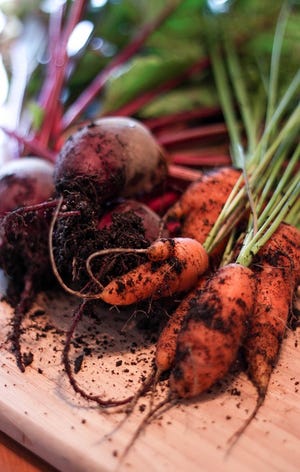Vegetable Gardening In Northeast Ohio
It appears that winter weather has finally made its way to Northeast Ohio right about the time that cabin fever is setting in.
Seed catalogs arrived months ago with the promise of bountiful harvest. We are ready to get gardening.
Even though it will be a few weeks until it is time for some tasks such as starting tomato seedlings indoors, there are plenty of things you can do now to gear up to veggie garden this spring.
Make a plan.If you haven't already, draw a diagram of last year's veggie garden. You need this to plan for rotation. Then sketch out your plan for this year. Ensure that you are not planning to grow something from the same family in the same place you grew it last year. In other words, do not plant tomatoes, peppers, eggplant or potatoes (all belonging in the solanaceous or nightshade family) in the same place you grew tomatoes last year. Rotating crop families helps avoid disease and pest issues. Plan for taller plants to be planted on the north and west sides to avoid shading shorter plants. Be sure your plan includes enough space for the crops you want to grow, and for the tasks needed to successfully garden such as watering, weeding and harvesting. Follow recommended spacing for different types of vegetables. This information can be found on seed packets or in university extension charts (see resources at the end of article). When plants are grown too close together, production will be lowered, plants will be stressed and more susceptible to pest and disease issues and it may be hard to move around in the garden, especially once plants are fully grown.
Create a list of supplies needed.If you are growing your own seedlings indoors, make sure your grow lights are in good working order, your containers or pots are clean, and you purchase seed starting potting mix. Order online or purchase seed locally. Some seed vendors are running a little behind schedule this year and there is usually a notice on their websites that will give you an indication of expected delays. Will you need to trellis anything you are growing such as peas, beans or tomatoes? Check your stock and see if you need to purchase or build more. Transplants will not be available in nurseries for a couple of months and should not be purchased too early.
Plan to direct seed or transplant.It really depends on the type of vegetable. Carrots, beans and peas are usually direct seeded. Seedling transplants should be used for pepper, tomato and eggplant. Many others can be either be direct seeded or transplanted. Transplants usually mature faster than direct seeded crops. However, this depends on weather and soil temperature.

Seedling that can be started now.Cool season crops such as cabbage, broccoli and lettuces seeds can be started indoors now. Peppers are a warm-season crop but need a little longer to grow to transplantable size and can also be sown now. Onion seeds should have been started by now but there is still time. In general, start seeds indoors six weeks before you want to plant them outside
How much should be planted?This depends on how large your household is and what everyone likes to eat. Once mature enough, fruiting crops such as tomatoes and peppers will continue to produce through the end of the season. Other crops such as spinach and carrots can be planted throughout the season for regular harvest. For a general estimate of number of needed plants, see Michigan State University's vegetable production chart. https://www.canr.msu.edu/uploads/files/Table%204.pdf.
Options for limited space.Using space on a deck, porch or a flat area, container gardening may be an option. Most vegetable crops can be grown in a container if it is big enough, there are drainage holes and the plant is provided adequate water, light and nutrients. If you do not have a site prepared but you have a flat, well-drained area, you could plan to install a raised bed. Although it is more desirable to prepare an in-ground gardening site a year before planting, it could still be done in the spring, but getting started will depend on when the snow melts and the soil dries. Another option would be joining a community garden in your neighborhood. Let's Grow Akron (http://letsgrowakron.org/) can inform you of community gardens near you.
Try something new.Each year, there are new and/or improved vegetable varieties on the market. Try something different, experiment and learn. My new vegetable variety this year is Japanese Truffle tomato. I will let you know how it goes.
To learn more.For more information on vegetable gardening preparation, see "Ten Steps to a Successful Vegetable Garden," https://web.extension.illinois.edu/vegguide/tensteps.cfm.
Vegetable Gardening In Northeast Ohio
Source: https://www.beaconjournal.com/story/lifestyle/2021/02/20/plant-lovers-almanac-garden-planning-summer-success/6787532002/
Posted by: mcbridepootnott.blogspot.com

0 Response to "Vegetable Gardening In Northeast Ohio"
Post a Comment